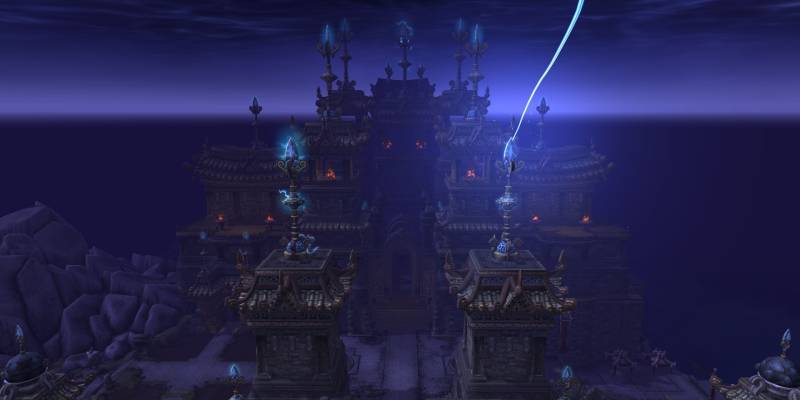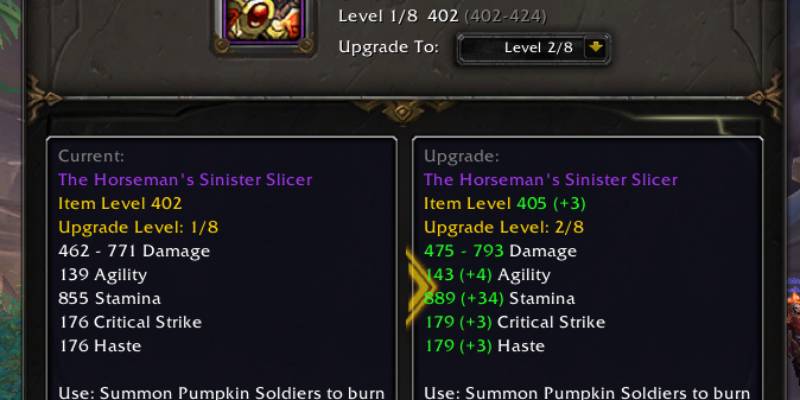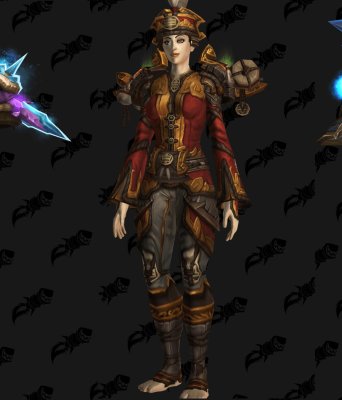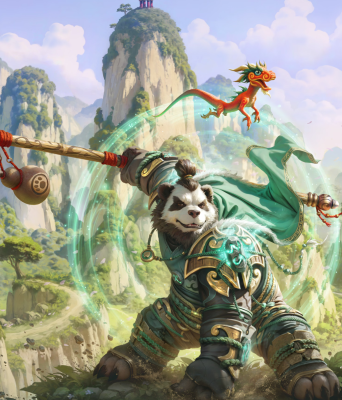Blizzard has announced major changes to Thunderforging for Mists of Pandaria Classic's Phase 3. The modifications fundamentally alter how players will pursue best-in-slot gear in Throne of Thunder, addressing a system that frustrated raiders back in 2012 while keeping the excitement of random loot upgrades intact.
What Thunderforging Was (And Why It Sucked)
When Throne of Thunder launched in 2012, Thunderforging introduced WoW's first RNG-based loot upgrade system. Every item from the raid had a small chance to drop as Thunderforged, adding six item levels. Sounds simple enough, but the execution created serious problems.
The impact was massive. A heroic weapon dropping at item level 535 would jump to 541 when Thunderforged. Take the Greatsword of Frozen Hells: the normal heroic version hits for 18,506 to 27,760 damage at 6,426 DPS. The Thunderforged version bumps that to 19,571 to 29,357 damage at 6,796 DPS. All secondary stats scale up proportionally: Strength from 1,679 to 1,780, Stamina from 2,639 to 2,790, Crit from 1,070 to 1,132, and Haste from 1,161 to 1,231.

Blizzard never disclosed the exact proc rate. But 25-man raids saw more Thunderforged drops purely because more loot dropped per boss, making it easier to funnel upgrades to specific players.
Getting full BiS became practically impossible. Item level mattered more in MoP than in previous expansions, so the power gap between Thunderforged and normal versions hit harder than the raw stats suggest. Players cleared Throne of Thunder week after week without seeing Thunderforged versions of critical pieces.
The Classic Solution: Same Max Power, Less RNG
Blizzard's modified system keeps Thunderforging but kills the frustration. The core change is brilliant in its simplicity.
Thunderforged items still drop with six bonus item levels, same as the original game. But here's the twist: Thunderforged items can't be upgraded further during Throne of Thunder progression.
Non-Thunderforged items now get two upgrade tiers through the item level upgrade system. Each tier costs currency and adds three item levels, totaling six. Do the math: a fully upgraded non-Thunderforged item hits the exact same item level as a Thunderforged drop.
Getting a Thunderforged piece saves the currency you'd otherwise spend on upgrades. That's still a nice bonus, especially early in the phase. But it doesn't give you an insurmountable power advantage over other raiders.
How the Upgrade System Works
The upgrade system stays active throughout Phase 3, unlike the original MoP where Blizzard removed it at launch and brought it back weeks later as a soft nerf.
Non-Thunderforged items start at 0/2 upgrades. During the first few weeks, each upgrade costs 250 Valor Points. Valor caps weekly, so this naturally gates progression speed.
Several weeks into Phase 3, the system swaps to Justice Points. Blizzard hasn't confirmed the exact cost, but Phase 2's pricing suggests 1,000 Justice Points per tier. Justice Points aren't capped and come from repeatable content like dungeons.
This matters most for players running multiple raid-ready characters. Instead of grinding dungeons on each alt immediately, you'll have a currency buffer ready to go.
What Can't Be Upgraded
Two gear sources don't get access to the upgrade system at all.
Tier pieces cap at item level 535. They couldn't Thunderforge in original MoP either since they drop directly from bosses, and that hasn't changed.
Shado-Pan Assault vendor gear caps at item level 522. This reputation gear follows the same logic: vendor items never had Thunderforging capability.
This creates interesting choices for some specs. Non-set pieces can hit 541 through upgrades while tier stays at 535. Breaking set bonuses for higher item level off-pieces becomes a real consideration.
When Thunderforged Drops Actually Matter
The Classic changes eliminate long-term Thunderforged advantages, but short-term value remains during early Phase 3.
Valor caps limit how fast you can upgrade everything. A Thunderforged drop during this window gives you max item level for that slot without spending Valor. This lets you allocate your limited early budget toward other slots or reputation purchases.

Several classes want to dump Valor into Shado-Pan Assault items. The Brutal Talisman costs 1,750 Valor and dominates trinket slots for many specs. Casters often need the Valor necklace since Phase 2 options are weak.
Once the system converts to Justice Points and players have time to farm currency, Thunderforged stops mattering. Everyone can reach full 541 equivalent gear through upgrades. You might need to run extra dungeons for Justice, but no time gate prevents you from maxing out.
Ra-den: The Guaranteed Exception
Ra-den breaks the Thunderforging rules. This secret thirteenth boss, available only in Heroic mode, guarantees all drops come Thunderforged at item level 541.
Ra-den also has unique restrictions. Raid groups get exactly 30 pull attempts per week. Fail to kill him within 30 tries and he despawns until next reset.
Blizzard's keeping the limited attempt system for Classic. This surprised some players since attempt limits aren't common in Classic re-releases, but the developers believe it's core to Ra-den's identity as a bonus challenge.
Testing Schedule and Phase 3 Timing
Throne of Thunder testing on PTR runs two windows. The first goes from November 4th at 10:00 AM PST through November 7th at 8:00 AM PST. The second starts November 14th at 10:00 AM PST and ends November 17th at 8:00 AM PST.
Blizzard scheduled a world boss test for November 7th at 3:00 PM. Players can try Oondasta, the boss up north on the Isle of Giants. Nalak will also be testable, though it won't be available in the live game until the Isle of Thunder fully unlocks.
Nalak's the Phase 3 equivalent of Sha of Anger. It drops current-tier PvP gear and tier pieces, making it valuable for both PvP and PvE players. But it's locked behind the zone's progression system.
Isle of Thunder: Progressive Unlocking
The Isle of Thunder opens through a server-wide war effort. Content unlocks in stages as the community completes objectives, similar to the Sunwell Island in TBC or the AQ war effort in vanilla.
The zone packs extensive daily quest chains. Initial quests unlock additional series as you progress. Rares and treasures scatter throughout the island for collection.
Nalak being time-gated behind full zone completion is the biggest restriction. PTR will run an accelerated unlock schedule so everything can be tested before live release.
Players at Exalted with the Tillers can take over Sunsong Ranch in Phase 3 by talking to Farmer Yoon.
Challenge Modes: Platinum Tier Rewards
Phase 3 adds Platinum completion times to Challenge Modes with new rewards. Each dungeon completed at Platinum difficulty grants an achievement and a toy.
These toys are Platinum versions of existing items. The Platinum Potion of Invisibility works like regular invis potions with an 18-second effect. Since toys are account-wide, every character gets access once you unlock it. No more buying consumable invis potions.
.jpg)
The Platinum Amber toy gives the amber encasement effect without paying the Klaxxi vendor repeatedly. Platinum Battle Banner comes from Scarlet Halls, and Platinum Battle Horn from Mogu'shan Palace.
Completing Platinum dungeons awards Platinum Coins alongside Challenge Conqueror achievements. Spend coins at the Challenge Mode Exchange vendor in the faction shrines. The vendor sells transmog recolors of Challenge Mode armor sets. Blizzard mentioned mounts will be available too, though they weren't in initial test builds. Expect alternate colors of the Ashen Pandaren Phoenix mount.
Realm first achievements go to the first groups completing all Challenge Modes at Platinum for Seasons 2 and 3.
Leaderboard Rewards
Challenge Mode leaderboards now grant seasonal titles and mounts for top realm times.
Players holding realm-best times when seasons end get exclusive rewards. Season 1 gives the "Mist Walker" title and Reins of the Celestial Serpent. Season 2 awards "Miststorm" and Reins of the Celestial Tiger. Season 3 offers "Heir to the Mist" with an unrevealed mount.
Celestial Updates
The Celestial encounters update for Phase 3 with LFR-quality Throne of Thunder gear drops.
Blizzard said the fights will incorporate boss mechanics from Throne of Thunder. This continues the pattern of Celestials evolving each phase to stay mechanically engaging rather than becoming trivial weekly clears.
Power Creep: Easier by Design
The modified system has one side effect: Throne of Thunder will be somewhat easier than the original 2012 version because everyone can reach higher item levels.
In original MoP, Blizzard removed upgrades at Throne of Thunder launch and reintroduced them weeks later as a soft nerf. Classic keeps upgrades from day one. Every raider can hit full Thunderforged equivalent, whereas this was statistically improbable in 2012.
Raid groups will have roughly six extra item levels across all gear compared to original MoP raiders at the same progression point. This makes encounters more forgiving.
But Throne of Thunder was designed as a significant difficulty jump over Tier 14 raids. Even with the item level advantage, many bosses should challenge groups properly, especially on Heroic.
Community Reception: Pros vs. Cons
Player reaction skews heavily positive with some reservations.
- Less RNG creating gear gaps between players doing identical content
- Player choice between upgrading items or buying reputation gear
- BiS actually becomes achievable without impossible RNG
- No need to bonus roll farm bosses forever chasing Thunderforged versions
- Less long-term raiding incentive once you hit full BiS
- No truly rare items anymore
- Thunderforced drops feel less exciting when you can just upgrade to match
Most players accept the trade-off. The Classic philosophy emphasizes community gameplay where dedicated players reach similar power levels. Fair beats exclusive.
Valor Strategy: Early Priorities
Shado-Pan Assault vendor items can't be upgraded, creating strategic tension for early Valor spending.
The Valor necklace is one of the strongest options for many specs since Phase 2 alternatives are weak. Buying it competes with upgrade costs.
The Brutal Talisman at 1,750 Valor is a huge investment competing directly with upgrades. These purchases create real decisions during Phase 3's opening weeks.
Thunderforged drops during this period genuinely help by freeing Valor for reputation purchases. A few lucky procs early on might let you grab both the necklace and trinket while unlucky players choose priorities.
Once Justice Points take over, this tension disappears. Farm unlimited Justice for upgrades while time-gated Valor goes exclusively toward reputation items.
Blizzard's Design Evolution
Original Thunderforging in 2012 was an experiment in extending gear progression and maintaining raid engagement. The system aimed to create excitement by making any kill potentially yield an upgraded version.
But Blizzard underestimated how much frustration would come from never truly completing BiS. In optimization-focused environments, the inability to finish a gear set created endless pressure to chase upgrades that might never drop.
The Classic revision fixes this while keeping the core concept that upgraded drops feel rewarding. Ensuring everyone reaches equivalent power through deterministic progression maintains fairness while letting Thunderforged drops provide the satisfaction of saved currency and immediate gains.
This reflects Blizzard's Classic philosophy: faithfully recreate content but fix systems that proved problematic. Rather than pure recreation, they're implementing thoughtful modifications that preserve the spirit while improving player experience based on a decade of lessons learned.
Prep Checklist
Players looking to maximize Phase 3 readiness should consider these steps.
Convert excess Valor to Commendations of Justice if you're done with Phase 2 upgrades. This provides the most efficient currency storage for Justice-based upgrades later.
Research your spec's gearing priorities to identify which Shado-Pan Assault purchases matter. Knowing whether you need the Valor necklace or trinket lets you plan early spending.
Study Throne of Thunder boss mechanics through guides and PTR observation. The raid will be easier than original thanks to higher item levels, but encounters remain complex and demand mechanical execution.
For Challenge Mode fans, practice current dungeons to prep for Platinum times. The rewards are substantial and account-wide across all characters.
Monitor PTR testing schedules if you want hands-on experience before live release.
As Throne of Thunder approaches, raiders can expect a gearing system that feels both rewarding and fair, letting groups progress through Lei Shen's fortress with clear paths to optimal power regardless of RNG.
Additional Phase 3 Content
Warlocks get access to the Codex of Xerrath questline, turning fire-based spell effects fel green. This cosmetic has been highly anticipated by the warlock community.
The Isle of Thunder zone itself features extensive content beyond just unlocking Nalak. Daily quest chains branch into additional series as you complete objectives. Rares and treasures populate the island for hunting and collection. The progressive unlock system mimics major past WoW events, giving the entire server a sense of working toward collective goals.
Players who achieved Exalted with Tillers during earlier phases gain immediate benefits. Taking control of Sunsong Ranch through Farmer Yoon provides ongoing utility for farming and material gathering. This represents one of the few reputation rewards that carries forward meaningfully into Phase 3 beyond simple achievement completion.
Challenge Mode enhancements extend beyond just Platinum times. The expanded toy rewards solve longstanding quality-of-life issues. Having account-wide invisibility through the Platinum Potion toy eliminates the need to stock consumables on every character. The Platinum Amber serves similar utility. These aren't just cosmetic additions but practical tools that reduce tedious preparation requirements across all characters on an account.
Blizzard clearly designed these rewards around items players actually use in Challenge Mode content itself. The Battle Banner and Battle Horn already see regular use for their buffs. Having Platinum versions that potentially don't share cooldowns (though this remains unconfirmed) would double their utility in high-level content.
The seasonal leaderboard structure with title and mount rewards gives competitive Challenge Mode players long-term goals beyond just completing dungeons once. Maintaining realm-best times requires consistent optimization and competition against other top groups. This transforms Challenge Modes from one-and-done content into an ongoing competitive scene similar to Mythic+ in retail WoW.




